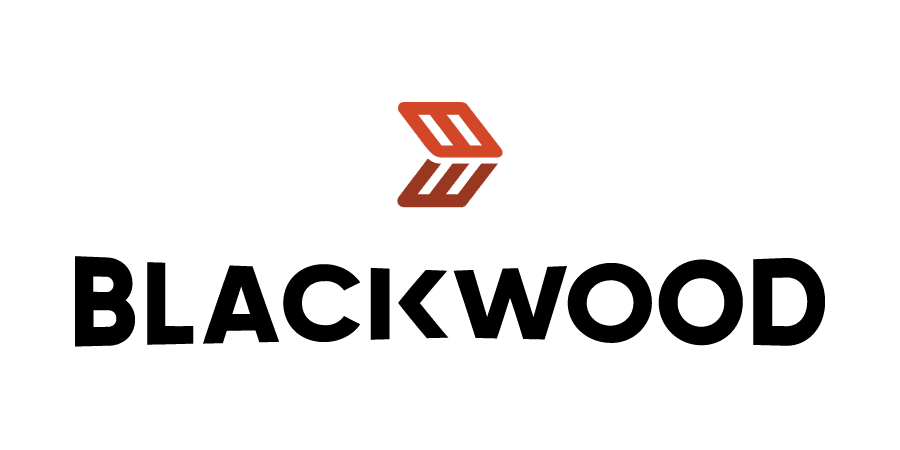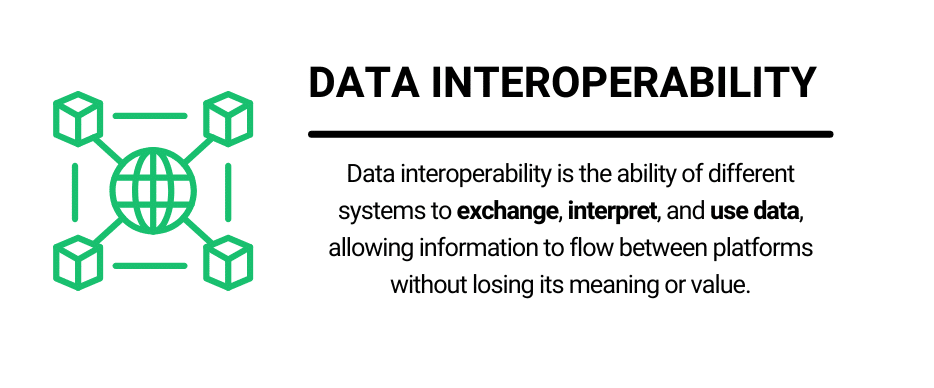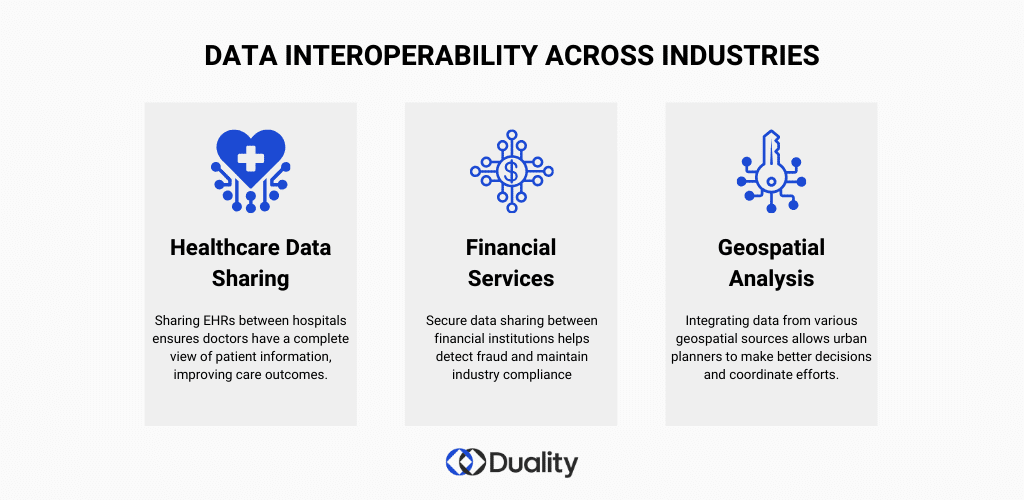Data is powerful—when it’s connected. Yet, for many organizations, valuable insights remain locked away in isolated systems, out of reach, and underutilized. This is where data interoperability comes in. Data interoperability is the ability to exchange, interpret, and use information across platforms without hitting roadblocks. With data interoperability, different sources of data can ‘talk to each other’, seamlessly sharing, synchronizing, and making sense of data. It’s the solution that turns isolated data into a strategic advantage, enabling exchange and collaboration.
In a world driven by insights, the ability to share data safely can mean the difference between stagnation and innovation. Let’s explore how data interoperability is reshaping how industries work together, unlocking new possibilities that were once out of reach.
The Challenges of Data Interoperability Across Industries
While the concept of data interoperability seems straightforward, the reality is far more complex.
One of the biggest challenges? Different systems speak different languages.
You can think of interoperability as a common language that different systems can speak and understand, even if they were built by different developers using different standards. Each has its own way of storing and processing data, making it tricky to align information. This is where semantic interoperability comes in, ensuring that the meaning behind data stays consistent across different systems, even if the data formats don’t match up perfectly.
Take healthcare, for example. Hospitals, clinics, and healthcare organizations use various information systems with unique data elements. it means a hospital’s electronic health record (EHR) system can communicate with a specialist’s database, ensuring that critical patient information moves where it’s needed. No friction, no delays. Aligning these systems is challenging, but it’s critical for accurate data exchange.
Similarly, financial institutions face challenges in exchanging data due to differing industry standards and regulations. There are even more regulations if you are collaborating in more than one country. For example, the United States and the EU have differing AI regulations.
Privacy regulations add an extra layer of complexity. For industries like healthcare, sharing sensitive information means navigating rules like GDPR, HIPAA, and fast healthcare interoperability resources (FHIR). These regulations protect privacy but can also slow down the data exchange, making cross-border or multi-party collaboration a challenge.
Then, there’s the issue of data silos. Many organizations store their data in isolated systems, cutting off valuable insights and making collaboration difficult. It’s like having all the pieces of a puzzle but keeping them in separate boxes. The result? Missed opportunities and slower progress.
Share Data Without Compromise
Achieve seamless data exchange across industries while keeping sensitive information safe.
Learn More
Use Cases: Data Interoperability Driving Collaboration in Key Sectors
Let’s explore some key interoperability use cases:
- Healthcare Data Sharing: When hospitals, clinics, and healthcare organizations share electronic health records seamlessly, patient care improves. It means doctors have access to the full picture, leading to better patient outcomes. Healthcare providers can visualize patient data from different sources, making better decisions in real-time.
- Financial Services and Fraud Detection: In finance, interoperability means sharing data securely between institutions. This is crucial for detecting fraud and ensuring compliance across borders. Technologies and tools like Fully Homomorphic Encryption make it possible to integrate data smoothly, ensuring that information flows without delays or risks.
- Geospatial Analysis and Urban Planning: Urban planners rely on interoperability to make sense of data from various geospatial sources. Using interoperability tools, they can analyze spatial data from different systems and use it to make smarter decisions about infrastructure and land use. This ensures that data from various geospatial information systems (GIS) remains compatible, supporting collaborative efforts between public agencies and private companies.
These examples show how interoperability is a practical solution that makes collaboration easier, faster, and more effective.
Best Practices for Implementing Data Interoperability
If you want to make data interoperability work, here’s a few tips:
- Use APIs to Connect Systems: Application programming interfaces (APIs) act as bridges, allowing software applications to share data without needing to fully integrate their internal structures. This is particularly useful in health data interoperability, where APIs can facilitate real-time data exchange.
- Standardize Your Metadata: Consistent metadata elements ensure that data keeps its meaning as it moves between platforms. It’s a key part of semantic interoperability, helping industries like healthcare and finance keep everything aligned—even when using different systems.
- Stay Compliant: Regulations like GDPR, HIPAA, and FHIR aren’t going anywhere, so it’s important to build compliance into your interoperability strategy. Compliance helps avoid legal issues while promoting trust among stakeholders.
- Leverage Web Tools for Data Integration: Web tools and technology platforms can help set up reliable interoperability connections and keep data flowing, even when working with complex spatial data.
- Invest in Privacy-Preserving Technologies: If you’re dealing with sensitive information, privacy-enhancing tools ensure that data stays secure throughout the entire exchange process, enabling collaboration without compromising privacy.
Following these steps makes it easier to build a reliable interoperability framework that adapts to your needs and keeps data moving in the right direction.
Future-Proof Your Organization with Duality
Achieving true data interoperability isn’t just about linking systems—it’s about doing it safely, without compromising privacy or breaking compliance rules. Duality offers a unique solution, allowing organizations to unlock the power of their data through secure, privacy-preserving collaboration.
Using advanced cryptographic methods like Privacy-Enhancing Technologies (PETs) and Fully Homomorphic Encryption (FHE), Duality lets you securely analyze, share, and compute on encrypted data without ever exposing the underlying information. And, it all happens while maintaining compliance with regulations like GDPR, HIPAA, and other global standards. It’s the freedom to collaborate, without the risk.
Where Duality Makes a Difference:
- Healthcare Research and Precision Medicine: Picture this—healthcare providers running collaborative studies on sensitive clinical data, discovering new treatments faster. Duality makes this possible, enabling research without compromising privacy. Precision medicine thrives when genomic data and patient records come together securely, fueling better insights and breakthroughs.
- Financial Services and Anti-Money Laundering (AML): Banks and financial institutions use Duality to detect fraud and stay on top of AML regulations, all while keeping sensitive information encrypted and protected. It’s like sharing secrets, but the secret stays safe.
- Collaborative AI Model Development: Training AI models on real-world data is powerful—but tricky. Duality lets developers access the data they need while keeping it encrypted. Train, test, and refine models without revealing sensitive information or intellectual property.
With Duality, data interoperability turns from a challenge into an opportunity. Suddenly, your data is free to flow across systems, empowering deeper collaboration and opening new doors—without ever risking privacy.
Break Down Data Silos, Collaborate Safely, and Drive Innovation
Book a Demo

















